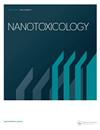使用体内测定的标准电池对二氧化钛纳米颗粒进行基因毒性评估。
IF 3.4
3区 医学
Q3 NANOSCIENCE & NANOTECHNOLOGY
引用次数: 0
摘要
作为纳米氧化物的代表之一,二氧化钛纳米颗粒(TiO2 NP)已被广泛使用,特别是在食品工业中。近年来,TiO2纳米粒子的遗传毒性引起了人们的极大关注。本研究旨在研究TiO2 NP(0、50、150和500 mg/kg BW)。在全面表征后,我们进行了一组标准的体内遗传毒性试验,包括染色体畸变试验(CA)、微核试验(MN)和彗星试验。所有这些测试的结果都是阴性的。小鼠骨髓细胞中没有结构或数量染色体异常,小鼠骨髓细胞的微核多染红细胞频率没有增加,大鼠肝细胞的%尾DNA也没有升高。这表明TiO2 NP不会引起染色体损伤或对DNA有直接影响。这些发现表明TiO2 NP没有表现出遗传毒性,并为风险评估提供了有价值的数据。本文章由计算机程序翻译,如有差异,请以英文原文为准。
Genotoxicity assessment of titanium dioxide nanoparticles using a standard battery of in vivo assays.
Abstract As one representative of nanometal oxides, titanium dioxide nanoparticles (TiO2-NPs) have been widely used, particularly in the food industry. The genotoxicity of TiO2-NPs has attracted great attention over the years. This study was undertaken to investigate the chromosome and DNA damage effects of TiO2-NPs (0, 50, 150, and 500 mg/kg BW) using rodent models. After a comprehensive characterization, we conducted a standard battery of in vivo genotoxicity tests, including the chromosomal aberration test (CA), micronucleus (MN) test, and the comet test. The results of all these tests were negative. There were no structural or numerical chromosomal abnormalities in mice bone marrow cells, no increase in the frequency of micronucleated polychromatic erythrocytes in mice bone marrow cells, and no elevation in % tail DNA in rat hepatocytes. This indicated that TiO2-NPs did not cause chromosomal damage or have a direct impact on DNA. These findings suggested that TiO2-NPs did not exhibit genotoxicity and provided valuable data for risk assessment purposes.
求助全文
通过发布文献求助,成功后即可免费获取论文全文。
去求助
来源期刊

Nanotoxicology
医学-毒理学
CiteScore
10.10
自引率
4.00%
发文量
45
审稿时长
3.5 months
期刊介绍:
Nanotoxicology invites contributions addressing research relating to the potential for human and environmental exposure, hazard and risk associated with the use and development of nano-structured materials. In this context, the term nano-structured materials has a broad definition, including ‘materials with at least one dimension in the nanometer size range’. These nanomaterials range from nanoparticles and nanomedicines, to nano-surfaces of larger materials and composite materials. The range of nanomaterials in use and under development is extremely diverse, so this journal includes a range of materials generated for purposeful delivery into the body (food, medicines, diagnostics and prosthetics), to consumer products (e.g. paints, cosmetics, electronics and clothing), and particles designed for environmental applications (e.g. remediation). It is the nano-size range if these materials which unifies them and defines the scope of Nanotoxicology .
While the term ‘toxicology’ indicates risk, the journal Nanotoxicology also aims to encompass studies that enhance safety during the production, use and disposal of nanomaterials. Well-controlled studies demonstrating a lack of exposure, hazard or risk associated with nanomaterials, or studies aiming to improve biocompatibility are welcomed and encouraged, as such studies will lead to an advancement of nanotechnology. Furthermore, many nanoparticles are developed with the intention to improve human health (e.g. antimicrobial agents), and again, such articles are encouraged. In order to promote quality, Nanotoxicology will prioritise publications that have demonstrated characterisation of the nanomaterials investigated.
 求助内容:
求助内容: 应助结果提醒方式:
应助结果提醒方式:


